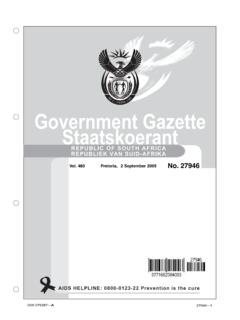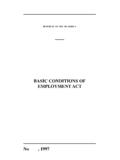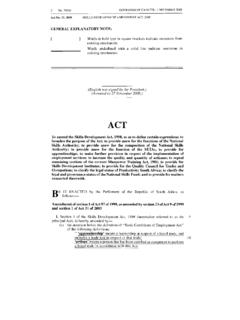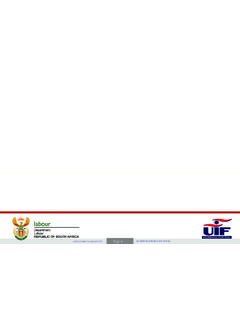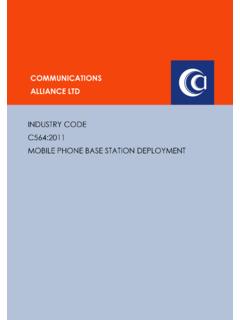Transcription of KNOW YOUR LRA - Department of Labour
1 know your . LRA. A guide to the Labour Relations Act, 1995. (as amended). Second Edition PUBLISHED BY THE Department OF Labour . know your LRA. Please note: This PDF file contains some blank pages. This has been done to ensure that this electronic version corresponds to the page numbering and pagination of the printed version of know your LRA - A Guide to the Labour Relations Act, 1995 (as ammended. Second Editon) which was released by the Department of Labour on 29 August, 2002. Some of the illustrations have also been removed in the interests of a smaller file size to allow for easier access. know your LRA. Department of Labour 2002. 2nd Edition Editorship: This publication fell under the general editorship of Mr Thembinkosi Mkalipi at the Department of Labour Publication co-ordinator: Dawn Norton Editors: Paul Benjamin and Mandy Taylor Writers: Lucelle Buchler, Michelle Moonsammy, Dawn Norton and Mandy Taylor Proof reader: Marisa van der Haar Design and layout: ContentAfrica and M & M Studios Illustrations: Mzwakhe Nhlabatsi and Drew Lindsay Cover: Drew Lindsay Distribution: Directorate of Communications, Department of Labour Acknowledgement: This is the second edition of know your LRA.
2 This edition updates the first edition published in 1997. Cheadle Thompson and Haysom Inc. and Carole Cooper, Robert Lagrange and Dora-Anne Pretorius at the Centre for Applied Legal Studies (CALS), at the University of the Witwatersrand developed the first edition. i know your LRA. ii Table of Contents INTRODUCTION VII. CHAPTER 1 WHO IS COVERED BY THE ACT? 1. Who does the Act cover? .. 2. Who does the Act not cover? .. 4. Do all employees covered by the Act enjoy identical rights? .. 4. CHAPTER 2 ORGANISATIONS OF EMPLOYERS AND EMPLOYEES 5. Promoting and protecting employees' and employers' rights .. 6. Registration of organisations .. 7. Requirements for registration : ballots, non-discrimination and independence .. 7. Rights of registered unions .. 8. Winding-up and cancellation of registration.
3 8. CHAPTER 3 ORGANISATIONAL RIGHTS 11. Organisational rights provided by the Act .. 12. How does a trade union acquire organisational rights? .. 13. Organisational rights and union membership .. 14. Disclosure of information .. 16. CHAPTER 4 UNION SECURITY ARRANGEMENTS 19. Agency Shop Agreements .. 20. Closed Shop Agreements .. 21. iii know your LRA. CHAPTER 5 CENTRALISED COLLECTIVE BARGAINING 23. How does the Act promote centralised collective bargaining? .. 24. CHAPTER 6 WORKPLACE FORUMS 29. Functions of a workplace forum ..30. Matters for consultation ..30. Matters for joint decision-making .. 31. Workplace forums and their relationship with collective bargaining ..32. Establishing a workplace forum ..32. Establishing a trade union based workplace forum ..33. Electing a workplace forum ..33. How do workplace forums operate?
4 34. Rights of workplace forums and their members ..34. Can workplace forums be dissolved? ..35. Workplace forums and other laws ..35. CHAPTER 7 INDUSTRIAL ACTION 37. Strikes and lockouts ..38. Strikes ..38. Lock-outs ..42. Compensation for loss attributable to a strike or lock-out ..44. Essential services ..45. Maintenance services ..46. Other forms of industrial action ..46. iv CHAPTER 8 UNFAIR TREATMENT IN THE WORKPLACE 51. Types of unfair Labour practices .. 52. Disputes about unfair Labour practices .. 53. Remedies .. 54. CHAPTER 9 DISMISSALS 55. What is a dismissal? .. 56. Some type of dismissal can never be legally justified .. 56. When is an employer legally permitted to dismiss an employee? .. 58. Dismissal for misconduct .. 58. Dismissal for incapacity .. 62. Dismissal for operational reasons (retrenchments).
5 63. Disputes over dismissals .. 69. Remedies for unfair dismissals .. 69. CHAPTER 10 THE TRANSFER OF A BUSINESS 71. The transfer of a business as a going concern .. 72. The transfer of contracts of employment in circumstances of insolvency ..74. CHAPTER 11 RESOLUTION OF DISPUTES 75. Dispute resolution institutions ..76. Basic procedures for the resolution of disputes .. 79. CHAPTER 12 IMPACT OF THE ACT ON PARTICULAR EMPLOYEES 85. Small businesses .. 86. Domestic workers ..87. Workers employed by temporary employment services ..87. Probationary employees .. 88. v know your LRA. CHAPTER 13 CODES OF GOOD PRACTICE 89. Code of Good Practice on Picketing ..90. Code of Good Practice on the handling of sexual harassment cases .. 91. Codes of Good Practice on dismissals based on operational requirements.
6 92. Code of Good Practice on key aspects of HIV aids and employment ..93. APPENDICES 95. An outline of statutory dispute procedures for different kinds of disputes ..96. Essential services ..99. Contact numbers .. 103. vi Introduction The Labour Relations Act (LRA), Act 66 of 1995 aims to promote economic development, social justice, Labour peace and democracy in the workplace. It sets out to achieve this by providing a framework for regulating the relationship between employees and their unions on the one hand, and employers and their organizations on the other hand. At the same time, it also encourages employers and employees to regulate relations between themselves. The Act promotes the right to fair Labour practices, to form and join trade unions and employers' organizations, to organize and bargain collectively, and to strike and lock-out.
7 In doing so it reflects the vision of employees' and employers'. rights contained in the Constitution. The LRA 1995 with the subsequent amendments sets out the rights of employers and employees and their organisations more clearly than before. This should provide the parties with more certainty with regard to the exercise of these rights. The Act also favours conciliation and negotiation as a way of settling Labour disputes. It expects parties to make a genuine attempt to settle disputes through conciliation before going on to the next step, which could be arbitration, adjudication or industrial action. By providing for a more simplified dispute resolution process, the Act aims to achieve a quick, effective and inexpensive resolution of disputes. It thereby aims to reduce the level of industrial unrest, and to minimize the need for costly legal advice.
8 The Commission for Conciliation, Mediation and Arbitration (CCMA) plays a critical role in actively conciliating and arbitrating disputes, and also provides advice on a range of issues to the parties concerned. This second edition of the booklet incorporates the 2002 amendments, which provides for the following: l the right to strike on retrenchments and facilitation of disputes around retrenchments;. l increased powers to bargaining councils and its officials;. l obliging bargaining councils to report to the Registrar on the activities of small business;. vii know your LRA. l better protection of vulnerable workers;. l increased powers of the Registrar in respect of bargaining councils and trade unions and employers' organisations;. l one stop conciliation and arbitration processes; and l one stop final and binding disciplinary enquiries (called pre-dismissal arbitration).
9 Content The Act guides employees and employers on: l the purpose, application and interpretation of the Act (LRA Chapter 1). l joining organisations (LRA Chapter 2). l organising and collective bargaining (LRA Chapter 3). l strikes and lock-outs (LRA Chapter 4). l participating in workplace decision-making (LRA Chapter 5). l registering and managing organisations (LRA Chapter 6). l settling disputes (LRA Chapter 7). l discipline and dismissals (LRA Chapter 8). l general provisions (LRA Chapter 9). l the establishment of institutions, transitional arrangements, and Codes of Good Practice (LRA Schedule 1-8). viii The Department of Labour and the role of other Labour laws Over the last few years, the Department of Labour has made great strides developing other employment legislation following the same tripartite process (ie involving negotiations between Labour , business and the government).
10 Acts passed include: l an employment standards law, the Basic Conditions of Employment Act, 1997;. l an employment equity law, to prohibit discrimination and to promote affirmative action, the Employment Equity Act, 1998;. l a skills development law and financing mechanism law to incentivise the growth of skills among workers, the Skills Development Act, 1998 and the Skills Development Levies Act, 1999; and l a revised social security law to assist employees who become unemployed, the Unemployment Insurance Act, 63 of 2001. These laws together with the LRA set the parameters for Labour relations in South Africa. How to use this guide This guide is a summary of key aspects of the LRA. At the end of each chapter you will find reference to the Act which you can consult for further information. Talk to a union organiser, personnel manager, Department of Labour official or a staff member at the CCMA if you have difficulty in understanding the Act.
